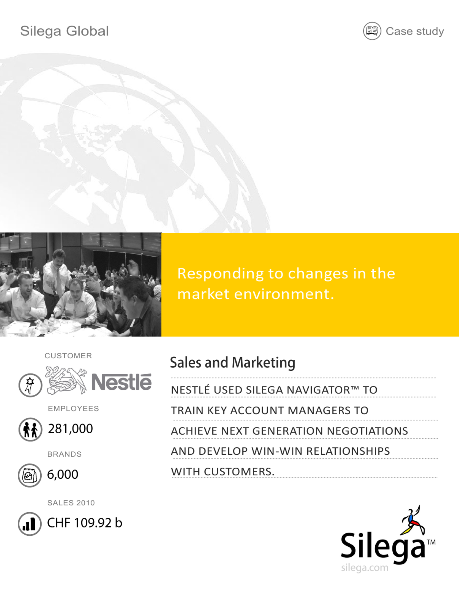Silega Navigator – Sales Growth and Chain Management Business Simulation
Improve productivity and stay competitive in changing times
Key objectives:
- Find new ways to improve both revenue and profit in a changing economy
- Better understand customer needs and improve both internal and external customer service
- Develop essential competencies and improve the bottom line
- Better focus employee activity and increase efficiency
- Make sales management, processes, and systems more effective
- Improve alignment between different departments (sales, marketing, and operations)
- Develop outstanding relationships, ongoing communication, and trust
- Inspire the sales force and service personnel, and create a sense of urgency
- Align sales with customer service, manufacturing, and finance
Key objectives:
- Find new ways to improve both revenue and profit in a changing economy
- Better understand customer needs and improve both internal and external customer service
- Develop essential competencies and improve the bottom line
- Better focus employee activity and increase efficiency
- Make sales management, processes, and systems more effective
- Improve alignment between different departments (sales, marketing, and operations)
- Develop outstanding relationships, ongoing communication, and trust
- Inspire the sales force and service personnel, and create a sense of urgency
- Align sales with customer service, manufacturing, and finance

The experience:
This program simulates four business years. Twelve teams represent different parts of the business supply chain, from providers to retailers.
We as Silega simulate the market. Participants compete in teams to create and sell different solutions. They have the opportunity to choose between six main products (the number can be adjusted for larger groups). In order to be successful, participants must manage relationships with other players, calculate costs and profit, and establish a marketing strategy.
This simulation is extremely dynamic with a lot of time pressure, running around, and fun. It is also very serious and impactful because we measure the reputation of all teams on the market in real time (based on feedback from the rest of the teams).
Participants must deal with fierce competition, tight resources, changing customer requirements, different market niches, lack of sufficient information, time pressure, and expectations from stakeholders and top management.
This simulation can also be used as a part of customer service training because it teaches participants how to better understand the voice of the customer, whether internal or external . If they don’t, participants experience losses and some teams may even go bankrupt.
| Format: | Business Simulation |
| Number of participants: | 10 to 200+ |
| Participant: | Sales directors, sales managers, account managers, territorial sales managers, sales force, marketing managers, areas that have interaction with customers, customer service managers |
| Duration: | 5 to 8 hours |
| Competencies: | Business acumen, customer focus, decision making, functional skills, negotiating, planning, problem-solving, process management, drive for results, strategic agility, managing through systems, building effective teams |
Typical applications:
- Sales force and marketing training
- Corporate training
- Customer service training
- Conferences and seminars, including annual meetings
- Team building
- Product launches and kick-off meetings
- Assessment centers
- Change management initiatives
Typical applications:
- Sales force and marketing training
- Corporate training
- Customer service training
- Conferences and seminars, including annual meetings
- Team building
- Product launches and kick-off meetings
- Assessment centers
- Change management initiatives

Key lessons:
- Develop competitive advantage on the market
- Sell at higher margins and find new products or service niches
- Better understand customer behavior, needs, and purchasing preferences
- Analyze key performance indicators (balanced scorecard, financial indicators) related to sales and marketing
- Develop an effective plan and forecasting model that can be used as a daily guideline
- Explore practical ideas to develop a penetration and retention strategy for each prospect
- Balance short-term profit, sustainable long-term value, and stakeholder confidence
- Optimize sales and marketing strategy, pricing, and value proposition
- Negotiate with customers that your company cannot afford to lose
- Develop critical product skills, strategic skills, and interpersonal skills
Key lessons:
- Develop competitive advantage on the market
- Sell at higher margins and find new products or service niches
- Better understand customer behavior, needs, and purchasing preferences
- Analyze key performance indicators (balanced scorecard, financial indicators) related to sales and marketing
- Develop an effective plan and forecasting model that can be used as a daily guideline
- Explore practical ideas to develop a penetration and retention strategy for each prospect
- Balance short-term profit, sustainable long-term value, and stakeholder confidence
- Optimize sales and marketing strategy, pricing, and value proposition
- Negotiate with customers that your company cannot afford to lose
- Develop critical product skills, strategic skills, and interpersonal skills


